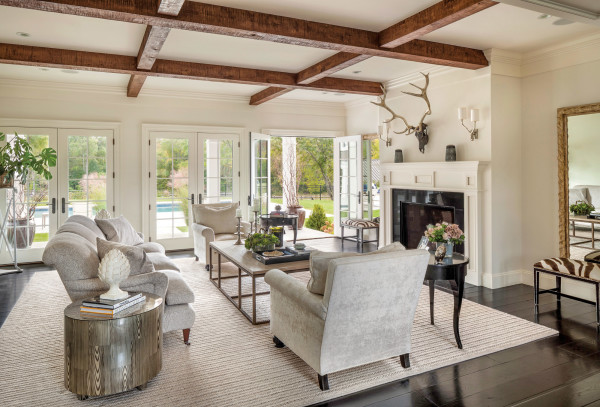
Appropriately detailed moldings and trim continue into the living room to reflect the formality of the space while the reclaimed timbers add character and warmth, reinforcing the farmhouse vernacular.
Anthony Crisafulli
Turning into the Dover, Massachusetts, property, you could be a visitor from the 1800s, coming to meet your prosperous new neighbors. Acres of wild grasses carpet the front property, intersected by a stone wall-lined drive. The gently curved road inspires sweet anticipation as it winds toward the Colonial Revival farmhouse. Centuries ago, you would likely find, at your destination, a family practicing self-sufficiency among their farm animals, gardens, and horses. And so it is today.
The 16-acre homestead off Farm Street is still dotted with outbuildings, gardens, and a barn. Children still find eggs in the chicken coop, and horses stand in stalls with iron hand-forged gates. An elegant country house still sits on the rise, an estate style beauty with a large central mass and wings suggesting, as in olden days, that the family has expanded over the years.
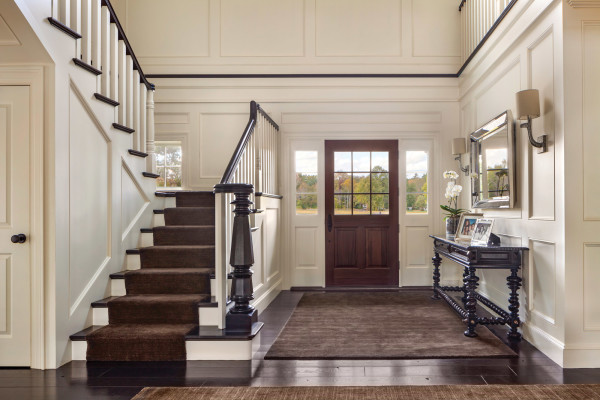
The entry hall and staircase are perfectly proportioned.
Anthony Crisafulli
While it has all the markings of historic architecture, this is a new home, designed by Patrick Ahearn, FAIA, to reflect the older homes around it. The key to the house’s authenticity is its expression of Ahearn’s commitment to proper scale, New England-borne materials, and—perhaps most importantly—a fitting script.
At his firm, with offices in Boston and Martha’s Vineyard, Ahearn and his staff write a script for each new project in historic neighborhoods. Every script serves as a roadmap for a newly built home and what its place will be among nearby centuries-old houses. The Dover property, at just over 5,000 square feet, is a classic example.
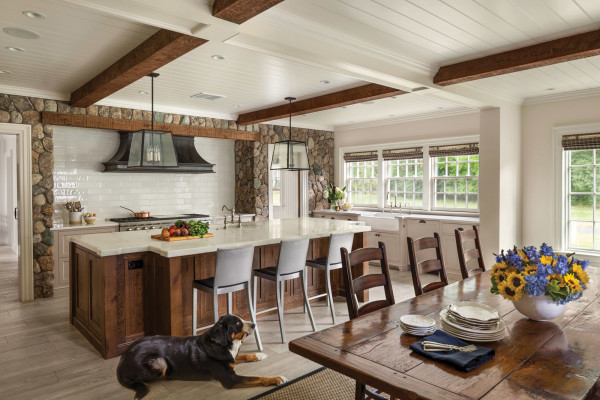
The use of natural stone and wood provide warmth and character in the farm-style kitchen and adjoining breakfast room.
Anthony Crisafulli
“This is an important piece of land surrounded by older houses and estates that are horse derivative,” says Ahearn, a Fellow in the American Institute of Architects and the winner of several Institute of Classical Architecture & Art–New England Chapter Bulfinch Awards. It was imperative, he adds, to reflect the mood and traditions set by the surrounding houses.
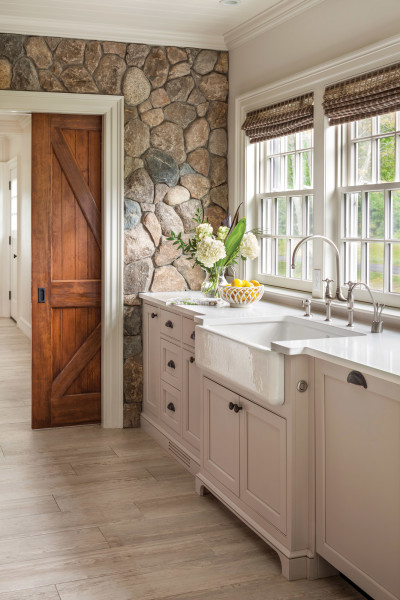
The side entry provides direct access to the informal living spaces including the mudroom. The space is appointed with sliding barn-style doors and has access to the second floor and basement via a secondary staircase.
Anthony Crisafulli
“When we think about this era of houses, there are certain elements: the 12 roof pitch, divided-light windows, a cedar shingled roof, white clapboard. All are elements that help portray character and themes of the house.”
Also common hundreds of years ago was the presentation of an assemblage of buildings, which Ahearn likens to a compound in today’s parlance. “When you think about New England vernacular architecture, especially in the more rural context, there was always a house, barn, and outbuildings,” he says. “There was a hierarchy of structures.” The assemblage of the buildings has its own implied history. As historic houses grew with the changing family size, the scale of additions usually shrank, Ahearn notes, so that “the original house remained dominant.” The chimneys—two in the central section and four total—are an important element in the structure’s lines, helping create verticality so the main body feels more dominant than the wings. An attached three-car garage is reminiscent of a carriage house, although in the 1800s would likely have been freestanding and connected to the house by a breezeway.
Making a New Old Home Blend In
While the house is beyond sight of Farm Street, Ahearn and his lead project designer, Michael Tartamella, AIA, were sensitive to neighbors who expressed appropriate concern about how a new home would affect the area. “We wanted this house to blend in and feel it could have always been there,” he says. “These are iconic houses. We wanted to reference those houses, albeit on a smaller scale.” It helped that Ahearn has designed homes on 200 acres in the area. The back of the house has a pleasing symmetry, which plays out in carefully placed bay windows, gables dropped into the face of the structure, and a center covered porch with a deck above. The back side design presents a pleasing drama in its connection to indoors and outdoors, Ahearn says, but at about 26 feet tall, it is small in scale. With the porch, a pool, and a screened room suggestive of post and beam construction, the back side of the house is highly animated, Ahearn says.
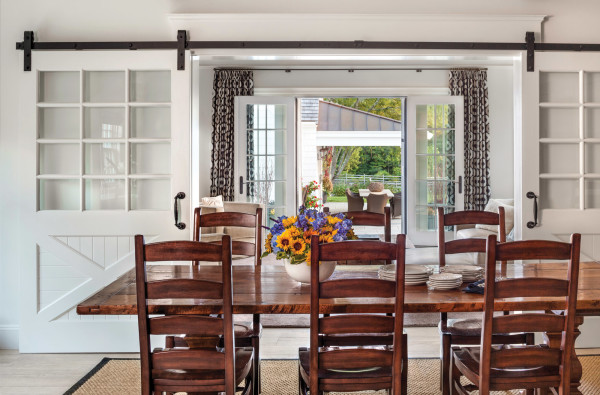
Ahearn uses sliding barn-style doors between the sitting room and breakfast room.
Anthony Crisafulli
Ahearn and the project builder, Bryan Sweeney of Sweeney Custom Homes and Renovations in Holliston, restored the barn, replete with a board-and-batten exterior. With its stained pine interior, ironwork demarcating the six stalls, and doors that slide on an iron track, the barn has a polished look worthy of a serious equestrian.
The homeowners, a young couple with several children, previously had lived in a more modern home. As they told Ahearn, they wanted to feel more in tune with the community and keep horses. The husband, who frequently travels for work, longed for a retreat. Because the family has frequent guests, the house also needed to accommodate large groups while imbuing the mood of a cozy homestead.
A gentle rolling terrain, stands of trees, and open fields imbue rich green shades in the summer and picture-postcard scenes in wintertime. “There are so many ways to celebrate the property,” Ahearn says. “It’s truly magical.”







